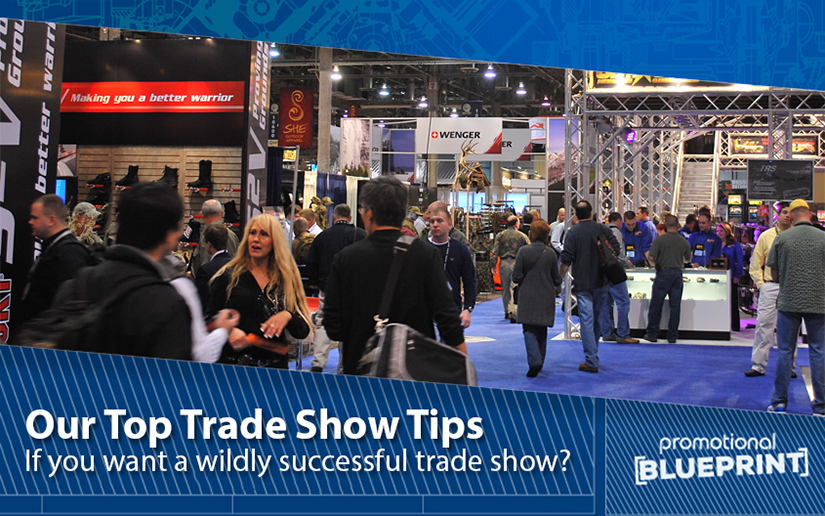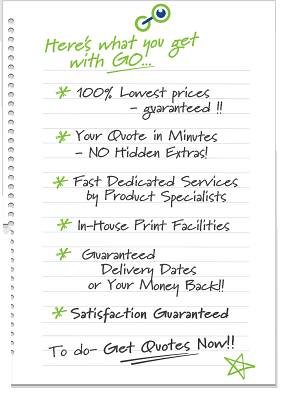So You Want a Wildly Successful Trade Show?

Our Top Trade Show Tips
Trade shows just aren't like they used to be when you'd staff a booth for a few days, gather some leads, give away some stress balls and do some followup. Times have changed. Attendee needs have changed. Markets and the economy have changed. And the path to a successful show is more elusive than ever. Putting together a successful presentation at a trade show has always been about details, innovation and a little bit of showmanship. Arming yourself with this organisational plan will help you get ahead of the game.
![]()
Purpose, Planning, Action, and Follow Up
Establish Your Purpose
Show participation is never cheap and of course you'll want to be able to get the biggest return on your investment. Keep your goals in mind: Why are you participating? Selling your product or services is the most obvious goal, but you may also be increasing brand or product awareness. You may be showing a new product, or meeting existing and potential clients. List the multiple takeaways you hope to achieve at the event, including getting feedback from potential clients about their needs. Market research should not be ignored as a key goal at any conference. Other potential goals may be to drive traffic to your website, or further develop your email marketing list.
Reach out two weeks before show date
It goes without saying that you'll call all your current clients and invite them to your show, but more important than that is to get a list of show attendees and pre-contact them and set up show appointments. If your booth is too small for seating, schedule the meetings at a nearby café or networking area of the conference. This is a perfect time for you to direct them to a page on your website so they can develop some questions for you.
The Nuts and Bolts of the Booth
Having a top notch blueprint is imperative, and commencing your planning sooner is better than later. While shows aren't cheap, you don't have to break the bank to make a whiz bang presence. This is another case where bigger is not always better. All it takes is planning, some tips and some creative thinking. First you'll need to establish your budget and decide on your booth size and content.
Your booth should be visually attractive and easy to navigate. Professionally printed backdrops are a must, and a plethora of kiosks, banners, flags, and signage are available to get creative with. The particular signage you choose is not as important as the professional look that you establish. Err on the side of too much signage if in doubt, because a sparse booth with the standard issue draping and a poster board clipped to it will scream “I'm small potatoes.” If you hope to spend considerable time chatting with visitors, consider chairs around a small table if space permits. Booths with seating garner 40% more traffic than booths without.
Brain Candy with the Eye Candy
Beyond the look/feel of the booth, you'll need to plan the actual use of your time in the booth. Revisit your goals list to decide the best way to maximise. If you are selling products, should you offer demos? If you need as many email addresses as possible, you might offer a prize drawing for signups. If your business has anything at all to do with internet or computer use, it is imperative to have computers in your booth.. Decide far in advance what printed materials you will distribute, i.e., brochures, business cards, postcards. Surprisingly, only about 10% of this material truly makes it back home with this visitor, so do not overspend on printing nor over distribute expensive catalogs. Instead look for ways to interact in the booth and capture the visitor. Use group input among your staff for decisions relating to booth materials and how you'll engage visitors.
Use an eye catching phrase in your signage or backdrop that's visible to a passerby. Maybe a statistic, client rosters, or award:
- “#1 Seller in the UK”
- “2010 Best Customer Service Award”
- “Increase your sales by 50%”
- “Acme consistently delivers on their promises with the lowest prices in town” quote by your favorite customer.
Here's where your creativity will come in to play, and something clever or entertaining or compelling will go a long way to draw them in to the booth.
Time Saving Must Have
Many trade show operators today are issuing attendee smart cards with registrant information captured on a magnetic stripe. If you have the option, rent the card swiper for your booth. It will more than pay for itself once you get back to your office and don't have to transcribe all that business card data. You'll have instant additions to your snail mail and email lists. If pertinent to your product, you'll be able to map potential buyers by post code. And of course, the best benefit is that it will allow you to do a quicker followup with your leads after the show.
“But what about stress balls?”
Part of the fun of shows for many are the countless free trade show giveaways on offer. But truthfully, those printed stress toys will likely be a doggie toy before dark. Give them something to remember you by that they can actually use. Looking at the sales trends at GoPromotional, the most popular items are still promotional pens. Low cost, cheap promotional pens are classically still a commodity in demand at a trade show, as people always need a pen to exchange info and take notes. Printed reusable coffee cups are another useful and wildly popular gift that is trending in 2018. Or go unique: if you stock your booth with printed power banks, branded notebooks, personalised printed mugs or an eye-catching item such as promotional rubiks cubes, word will spread (“Who's giving out the Rubik's Cubes?”) and you'll draw more people to your booth. This tactic is most effective if your goal is to increase your email list. Whatever you choose to give away, don't put them out in a pile on the table for attendees to just pick up unless your goal is to spread your brand without interaction. It's entirely acceptable to offer the freebies after a chat or email signup.
It's Showtime
You'll likely get all show attendees walking by your booth at some point, and while they'll certainly notice your booth and branded promotional merchandise, your staff and your creativity is what will catch them. As they're walking by, you're likely to experience two distinctly different types of interaction. First will be a visual perception from those who will be enlivened by the looks of your staff and booth. Studies have shown that even things like colour matter. Staffers with vivid clothing are more likely to stimulate - even an eye catching tie on a man's suit can work.
Next will be a behavioral reaction, based on your interactions with them. This is where your well trained staff comes in. A little psychological marketing will go a long way here: You must know and accept ahead of time that buyers really don't want to purchase your product. They simply want answers and solutions, and their lives made easier. Your product is merely the vehicle. Don't sell the product. Sell the solution. Avoid features and benefits until later. Your staff must be able to determine what those problems are in the first few sentences, even though the buyer will usually be inclined to walk directly to your product.
Train and Practice
Having a top notch well trained staff is your best tool, more important than your booth and materials. As trade show participation has evolved; visitors these days are doing less browsing and more targeted evaluations.
You can expect to have about a minute to give a qualifying pitch, then about five minutes after interest is determined. The longer they stay, usually the better, but read them carefully and don't drag on. The last thing they want is a hard sell. Practice your “elevator speech”, the one minute description of what your company does. Decide up front what types of questions you will ask visitors to determine their needs. Practice and engage the visitor in the first minute with questions about their needs.
Additionally, you're likely to see more buying teams instead of single attendees as in the past. Time is important to companies, and by visiting shows together, buying teams will all be on the same page when making decisions later. Remember, buying teams can be tougher because of group-speak. They want to be catered to, so pay attention to each of them.
Implementing these tactics will assure your next show presence to be successful. And keeping up with trends will let your clients know that you have the mojo to be on their side. Now go get a show calendar and decide which ones you'll be participating in this year. And remember that this is just like show business, so have fun and make it fun. You'll come out smiling and your sales crew will too.

Trust Us and you'll be in fantastic company












Winners of the Promotional Merchandise Distributor of the Year Award
Members of the BPMA, Promota, PPIA and The Advertising Speciality Institute












